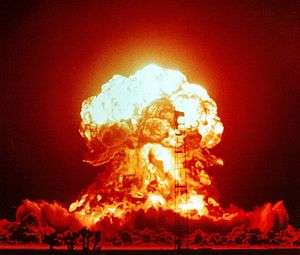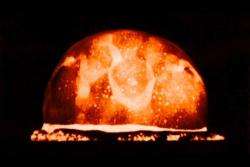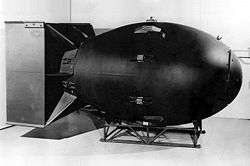Nuclear explosion


| Nuclear weapons |
|---|
 |
| Background |
| Nuclear-armed states |
|
A nuclear explosion is an explosion that occurs as a result of the rapid release of energy from a high-speed nuclear reaction. The driving reaction may be nuclear fission, nuclear fusion or a multistage cascading combination of the two, though to date all fusion based weapons have used a fission device to initiate fusion, and a pure fusion weapon remains a hypothetical device.
Atmospheric nuclear explosions are associated with mushroom clouds, although mushroom clouds can occur with large chemical explosions, and it is possible to have an air-burst nuclear explosion without these cloud's Nuclear explosions produce radiation and radioactive debris.
Any nuclear explosion (or nuclear war) would have wide-ranging, long-term, catastrophic effects, that could threaten the survival of humankind. Radioactive contamination would cause genetic mutations and cancer across many generations.[1]
History
In 1963, the United States, Soviet Union, and United Kingdom signed the Limited Test Ban Treaty, pledging to refrain from testing nuclear weapons in the atmosphere, underwater, or in outer space. The treaty permitted underground tests. Many other non-nuclear nations acceded to the Treaty following its entry into force; however, three nuclear weapons states have not acceded: France, China, and North Korea.
The primary application to date has been military (i.e. nuclear weapons). However, there are other potential applications, which have not yet been explored, or have been considered but abandoned. They include
- Nuclear pulse propulsion, including using a nuclear explosion as asteroid deflection strategy.
- Power generation; see PACER
- Peaceful nuclear explosions
Nuclear weapons are largely seen as a 'deterrent' by most governments; the sheer scale of the destruction caused by a nuclear weapon has prevented much serious consideration of their use in warfare, rendering the concept of total war completely useless.
Nuclear weapons
Only two nuclear weapons have been deployed in combat—both by the United States against Japan in World War II. The first event occurred on the morning of 6 August 1945, when the United States Army Air Forces dropped a uranium gun-type device code-named "Little Boy" the city of Hiroshima, killing 70,000 people, including 20,000 Japanese combatants and 20,000 Korean slave laborers. The second event occurred three days later when, again, the United States Army Air Forces dropped a plutonium implosion-type device code-named "Fat Man" on the city of Nagasaki, killing 39,000 people, including 27,778 Japanese munitions employees, 2,000 Korean slave laborers, and 150 Japanese combatants. In total, around 119,000 people were killed in these bombings. (See Atomic bombings of Hiroshima and Nagasaki for a full discussion).
Nuclear testing
Since the Trinity test and excluding the combat use of nuclear weapons, mankind (those few nations with capability) has detonated roughly 1,700 nuclear explosions, all but 6 as tests. Of these, six were peaceful nuclear explosions. Nuclear tests are experiments carried out to determine the effectiveness, yield and explosive capability of nuclear weapons. Throughout the 20th century, most nations that have developed nuclear weapons had a staged tests of them. Testing nuclear weapons can yield information about how the weapons work, as well as how the weapons behave under various conditions and how structures behave when subjected to nuclear explosions. Additionally, nuclear testing has often been used as an indicator of scientific and military strength, and many tests have been overtly political in their intention; most nuclear weapons states publicly declared their nuclear status by means of a nuclear test.
Effects of nuclear explosions
The dominant effects of a nuclear weapon (the blast and thermal radiation) are the same physical damage mechanisms as conventional explosives, but the energy produced by a nuclear explosive is millions of times more per gram and the temperatures reached are in the tens of megakelvins. Nuclear weapons are quite different from conventional weapons because of the huge amount of explosive energy they can put out and the different kinds of effects they make, like high temperatures and nuclear radiation.
The devastating impact of the explosion does not stop after the initial blast, as with conventional explosives. A cloud of nuclear radiation travels from the epicenter of the explosion, causing an impact to life forms even after the heat waves have ceased.
Any nuclear explosion (or nuclear war) would have wide-ranging, long-term, catastrophic effects, that could threaten the survival of humankind. Radioactive contamination would cause genetic mutations and cancer across many generations.[2]
See also
- Lists of nuclear disasters and radioactive incidents
- Soviet nuclear well collapses
- Visual depictions of nuclear explosions in fiction
References
- ↑ Malcolm Fraser and Tilman Ruff. 2015 is the year to ban nuclear weapons, The Age, February 19, 2015.
- ↑ Malcolm Fraser and Tilman Ruff. 2015 is the year to ban nuclear weapons, The Age, February 19, 2015.